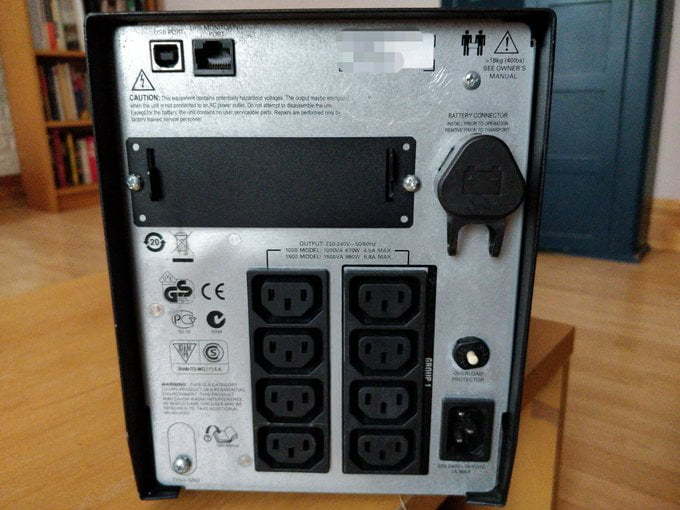I never get power cuts. But, we've had two in the last week. They've both been fixed quickly, but it takes an age for my cable modem to reboot - and then an age for my smarthome to reconnect to the WiFi. So it was time to invest in an Uninterruptible Power Supply (UPS).
My friend Paul Curry recommended the APC SMT1500i. It usually retails for around £700, but I found a refurbished one for £200
Let's put it through its paces!

It's a chunky monkey! And weighs about 25Kg. So best set it on the floor, or a really sturdy shelf. It's about the same size and shape as a PC tower - with an array of blinkenlights and buttons on the front.

It's pretty simple to use. Plug it in to the mains using the supplied kettle leads. It'll make some beeping noises and the batteries will start to charge. This causes the fans to spin. They're not overly noisy - but they turn off after 3 hours when the unit is fully charged. The unit sits passively quiet until there's a power cut.
You'll notice that on the back are eight IEC sockets. You'll need an IEC to UK plug adapter in order to connect your electronics.
And... that's it. I charged the UPS, plugged my kit in, then unplugged the UPS from the wall to simulate a power cut. It immediately started beeping, to let me know it had lost power, and its little lights started flashing. And, most importantly, all of my gadgets stayed on!
It can output 1kW for about 6 minutes - for a more modest 400W, it'll run for half an hour. So should be able to keep most gadgets going but it isn't going to run your gaming rig for several hours.
Importantly, it has serial control, so you can tell your servers to gracefully shutdown when the power goes out. Let's take a look!
Linux Usage
The RJ45 port is not, sadly, Ethernet. It's a serial port. Kinda redundant as there's a USB-B port as well. Plugging it in to a Linux machine gets you this on lsusb: 051d:0003
Although APC provide their own software, it seems a bit outdated and doesn't fully support Linux.
There's a good tutorial to get the UPS talking to Ubuntu.
Once that's done, you can monitor the battery from the command line. I wasn't able to find a way to upgrade the firmware, or do anything fancy like that. But it seems to show all the basics.
Overall, it's a great little UPS.

6 thoughts on “Gadget Review: SMT1500i UPS + Linux Instructions”
@Edent I recently invested into a UPS as well 🙂 Already saved me a bunch of time as I had to change the plug here (just move the wallplug from one socket to another socket)...Didn't have to shutdown my servers n shit just for that :^)
| Reply to original comment on social.linux.pizza
JH
If its just a small device like a modem that needs keeping going during a temporary power cut ,I found a small unit on Amazon the iLEPO Mini UPS Uninterruptable Power Supply that does it for me.The unit runs of 4 x 8800mAH lithium batteries. https://www.amazon.co.uk/gp/product/B07R4FGWDX/ref=ppx_yo_dt_b_asin_title_o04_s00?ie=UTF8&psc=1
This bit of kit protects all my important stuff in my home office, as sometimes the Powerwalls don't switch instantly. Great product and replacement batteries are not too much.I have the C1500 which has ethernet.
| Reply to original comment on twitter.com
I thought you’d be tempted!
Remember to factor in replacing the battery every few years (sorry; vague, I know), unless you just want to bridge increasingly short outages.
| Reply to original comment on twitter.com
I use github.com/mdlayher/apcup… to log the voltages to prometheus off my APCs
| Reply to original comment on twitter.com
I didn’t spot this at the time, I’m glad it’s working well for you! That model has the expansion port too…
| Reply to original comment on twitter.com
What links here from around this blog?